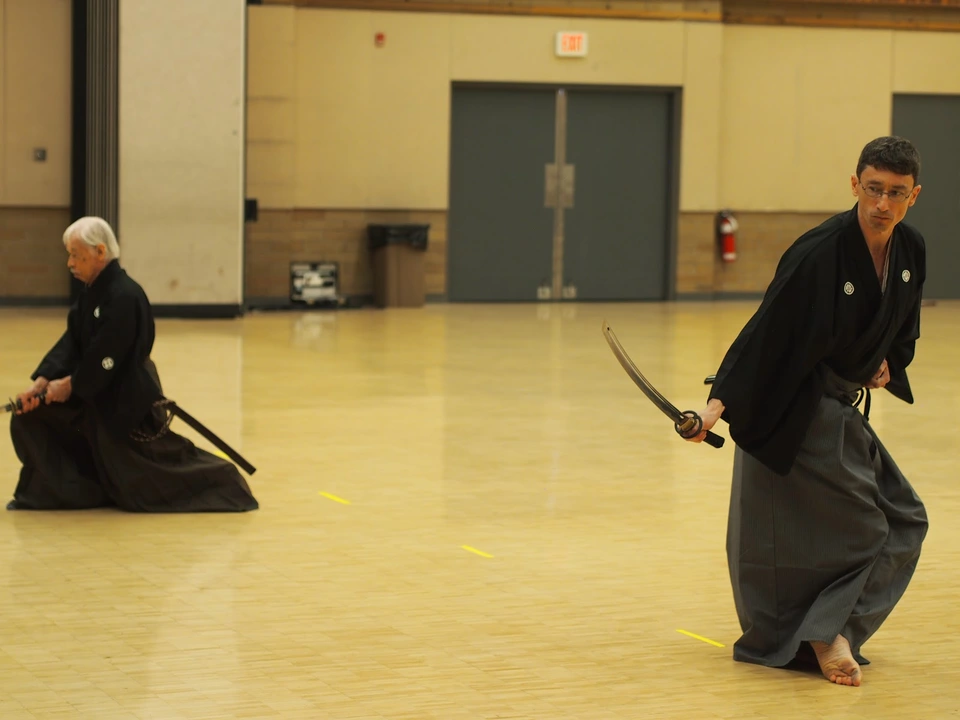Iaido is a martial art focused on drawing and sheathing a sword. It is often practiced with a sensei or teacher, however, it is possible to practice solo. Learning Iaido without a sensei is a challenge, but can be done with patience and dedication. Here are some tips for those wanting to practice Iaido solo.
Do Your Research
The first step to practicing Iaido solo is to do some research. Read up on the basics of Iaido, such as the stances, footwork, and techniques. Familiarize yourself with the terminology and the different styles of Iaido. This will provide a foundation for your solo practice.
Learn the Basics
Once you have a basic understanding of Iaido, the next step is to learn the basic movements and stances. Start with the footwork and then focus on the drawing and sheathing of the sword. Practicing these movements in front of a mirror can help you to ensure you are doing them correctly. It is also important to focus on proper form when practicing Iaido, as this will help to prevent injury.
Practice with a Partner
Although you may be practicing solo, it can be helpful to practice with a partner. This can be a great way to refine your technique and to learn from each other. When practicing with a partner, be sure to wear protective gear and to go slowly. This will help to prevent any injuries.
Find Online Resources
There are many online resources available for those wanting to learn Iaido, such as instructional videos and forums. Taking advantage of these resources can be a great way to supplement your solo practice. Watching videos of experienced practitioners can provide insight into proper form and technique.
Be Patient
Finally, it is important to be patient when practicing Iaido solo. Learning the art takes time and dedication, and it may take longer without the guidance of a sensei. However, with patience and dedication, it is possible to learn and master Iaido without a sensei.
?Having trouble mastering the techniques of Iaido without a sensei? Fortunately, there are plenty of ways to practice the martial art and still make progress, even without a teacher. YouTube and books are two great resources to use to help you learn the techniques of Iaido.
YouTube
YouTube is a great resource for learning Iaido, as there are many videos created by experienced practitioners that can show you how to do the various techniques. When watching videos, be sure to pay attention to the details of the technique, such as the footwork and body positioning. You can also pause and rewind the video to make sure you are doing the technique correctly. Additionally, there are often videos that explain the basics of Iaido, such as the stances, strikes, and blocks. It's important to understand the basics before attempting any of the more advanced techniques.
Books
Books are also a great resource for learning Iaido. There are many books available that provide detailed instructions on how to do the various techniques. Additionally, books often provide explanations of the philosophy behind Iaido, which can help you to better understand the martial art. It's important to read the books thoroughly and make sure you understand what you are reading before attempting any of the techniques.
By using YouTube and books, you can learn the techniques of Iaido, even without a sensei. Make sure to pay close attention to the details and read the books thoroughly to get the most out of your practice. With enough practice and dedication, you can master the techniques of Iaido.
Iaido is an ancient martial art that requires a great deal of stamina to master. The traditional practice of Iaido requires a sensei, or teacher, to guide students through the movements. However, it is possible to practice Iaido without a sensei and still improve your stamina.
The first step in building stamina for Iaido is to familiarize yourself with the basics. Learn the footwork, stances, and hand positions of Iaido. Watch instructional videos, read books, and practice the basics on a regular basis. This will help you understand the movements better and give you a better foundation for building your stamina.
Once you’re familiar with the basics, you can start to focus on building your endurance. Try to do basic Iaido exercises every day. Start with a few minutes of practice and gradually increase it over time. Incorporate short bursts of speed and intensity into your practice to help build your endurance. Be sure to take breaks in between exercises to rest and recharge.
You can also use a timer to measure and track your progress. Set a goal for yourself and practice for a certain amount of time each day. As you practice, keep an eye on the clock and try to beat your previous time. This can help you gradually increase your stamina and endurance.
Finally, don’t forget to take care of your body. Proper nutrition, hydration, and rest are all essential for building stamina. Make sure you’re eating healthy meals, drinking plenty of water, and getting enough sleep. These will all help to keep you healthy and energized while you practice Iaido.
Practicing Iaido without a sensei can be challenging, but it is possible. By familiarizing yourself with the basics, incorporating intensity into your practice, setting goals, and taking care of your body, you can gradually build your stamina and endurance over time.
Iaido is a Japanese martial art that involves drawing a sword and cutting down an opponent in a single motion. It requires a great deal of skill and practice in order to master the technique, and usually involves a sensei to teach and guide the student. However, it is possible to practice Iaido without a sensei, as long as you have the right gear.
The most important piece of gear for practicing Iaido alone is a bokken. A bokken is a wooden sword that is shaped like a traditional Japanese katana. It is used for practicing techniques such as drawing, cutting, and blocking. It is also a much safer option than a real sword, which can be dangerous if not handled correctly. It is important to use a bokken that is the correct size and weight for your body type.
Another essential piece of gear is a tatami mat. A tatami mat is a type of Japanese flooring made of rice straw, and is used to provide cushioning when practicing Iaido. It is important to have a good quality tatami mat to provide the right support while practicing. It also helps protect your feet from injury while performing the techniques.
Finally, it is important to have a mirror. A mirror can be used to observe your technique and make sure you are performing the movements correctly. This is especially important when practicing Iaido solo, as you don't have a sensei to observe and correct your technique. It is also important to take the time to watch videos of experienced practitioners in order to get an idea of how the techniques should look.
Practicing Iaido without a sensei can be challenging, but with the right gear and dedication, it is certainly possible. With the right bokken, tatami mat, and mirror, you can practice Iaido safely and effectively.
Although it can be a challenge, it is possible to improve your Iaido skills without having a sensei to guide you. Here are some tips to help you on your journey:
1. Watch Videos and Learn
The internet is a great source of information and videos on Iaido. Watching videos of experienced practitioners can help you to understand the basics of Iaido and the movements involved. There are also many books and guides available that can help you understand the principles and techniques of Iaido.
2. Find a Training Partner
Having a training partner can be invaluable when learning Iaido without a sensei. Training with someone can help you to stay motivated, provide feedback and help you with any questions you may have. It can also help to keep you safe when practicing the techniques.
3. Practice Mindfully
Iaido is an art of precision and mindfulness. As such, it is important to practice with focus and intention. Pay attention to the details of each movement and the sensations in your body. This will help you to develop good habits and improve your technique.
4. Take Time to Reflect
It is important to take time to reflect and review your progress. If you are able, attend Iaido seminars and classes to get feedback from experienced practitioners. Alternatively, you can review videos of your practice to identify areas of improvement.
5. Don’t Give Up
Practicing Iaido without a sensei can be challenging and at times frustrating, but it is important to stay motivated and persevere. With patience and dedication, you will be able to improve your Iaido skills and achieve the level of mastery you desire.

